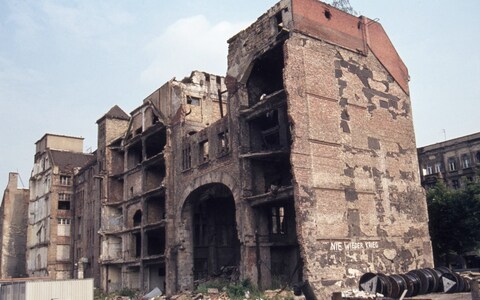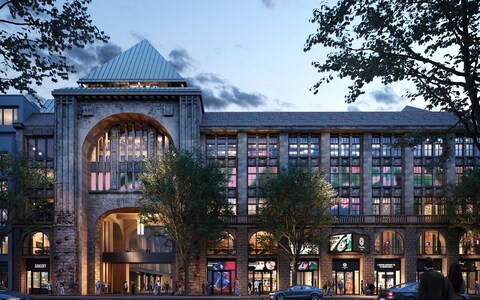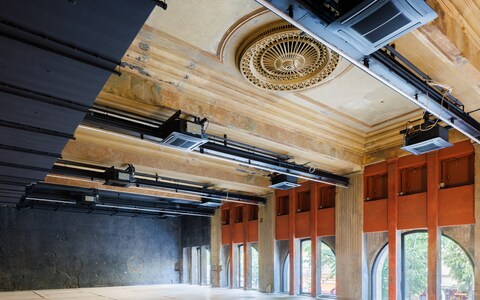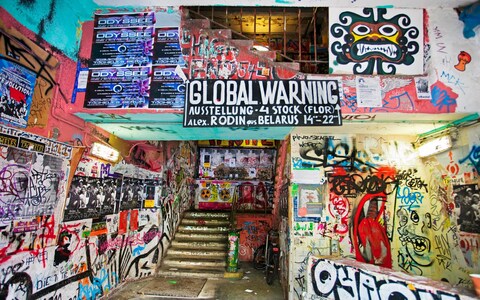Tim Roeloffs found exactly what he was looking for when he first visited Tacheles: “Artists doing crazy stuff”.
“Fighting at night with disused Russian tanks as performance art. Huge parties in the basement. Everywhere was covered in graffiti. I thought, my God, what are they doing? It all happened in Tacheles.”
The Dutch artist, now 58, arrived in Berlin in 1990 in search of energy, space and freedom. Like thousands of young people from all over Europe, he was drawn to the post-unification German capital, then synonymous with all three.
He found utopia in a ruined department store. The massive Kunsthaus Tacheles – or “straight-talking art house” – was, for a brief time, an anarchic wonderland, squatted by artists and open 24 hours a day.
The hulking site offered low-cost studio space (some say they paid 50c a year). Donatella Versace, in search of talent, found Roeloffs working in his studio here and commissioned him to design textiles. Tourists sought out Tacheles as a symbol of Berlin’s exhilarating counterculture. Inevitably, it became a little tacky. After just over two decades, the artists were evicted in 2012 to make way for development.
“I lived and worked there until the bitter end,” says Roeloffs. “In the end, I lost a court case. I was the last to go.”
Interior of the Kunsthaus Tacheles, August 2009
Credit: agefotostock / Alamy Stock Photo
Now, the site has reopened as “Am Tacheles”, after a nine-year refurbishment and building project by developers PWR. It is home to Fotografiska, the slick Stockholm-based commercial gallery chain specialising in contemporary photography, which occupies six floors of the old building and includes galleries, a high-end restaurant and bars. A new, vastly wider complex includes a public plaza, apartments with private courtyards, offices and a glitzy shopping mall. Star Swiss architects Herzog & de Meuron led the work.
But as Roeloffs puts it: “What happened to Germany happened in that place, too.” An earlier, more sinister history lies in the bones of Tacheles.
The old building embodies the history of Berlin, tracking each era from overweening ambition, spectacular bankruptcies, Nazi oppression, violence, war and redemption. “A metaphor for everything,” says Roeloffs.


Tim Roeloffs found exactly what he was looking for: Kunsthaus Tacheles in 1990
Credit: ullstein bild
Built in 1907-8 between Oranienburger Straße and Friedrichstraße in Berlin-Mitte as a lavish, Jewish-owned department store and shopping arcade, complete with nouveau tiling and wide, glass coppola. But its first iteration was short-lived. After the First World War, and during and after the Weimar Republic hyperinflation crisis, it was downgraded to an electricity showroom.
By the 1930s, the site had been commandeered by the Nazis, who used part of it as a jail for prisoners of war. Perhaps this was a symbolic commandeering – Tacheles is located in what was once a Jewish quarter of the city. Eventually, they turned it into SS headquarters, administrative home to the violent security wing of the Third Reich. Much of the structure was reduced to rubble in Second World War bombing raids.
After the war when the allies divided Berlin, Tacheles lay on the eastern side, neglected and empty. The DDR embarked on a Soviet-style building spree, complete with grand boulevards and a people’s palace.


City view of Kunsthaus Tacheles on Oranienburger Strasse ca. 1976
Credit: ullstein bild
West Berlin, too, attempted to turn from the past to the future, with the restoration of the ruined Reichstag and grand plans for Hauptstadt, an international architectural competition for a complete urban development, in 1957/8. Hauptstadt was to have been an entire, ultra-modern district, a signal to the future, though it proved too expensive and was never realised.
The old Tacheles stands today only by chance. Its demolition to make way for an autobahn had been set for April 1990 by the DDR – five months after the wall came down and the city was reunified.
After reunification, Berlin became a construction site, with large commissions designed to promote more future-facing dynamism, including another Reichstag redesign and the Humboldt Forum.
Now it is Tacheles’ turn, and the architects have reflected every phase of Tacheles’ history – including its Nazi period – in their overhaul. They want Tacheles to be recycled and transformed by virtue of the darker episodes in its past, into a place of redemption, despite having to work with a palimpsest.


Fotografiska Berlin: The Contemporary Museum of Photography, Art and Culture which had replaced the Kunsthaus Tacheles
“It was hard to identify the 1940s elements, because much was covered by the 90s,” says Yasmin Kherad, Herzog & de Meuron’s Berlin studio director. “We did full mapping for the entire building, documenting every single wall and door. But there was not much left: one staircase, still with beautiful tiles, a few windows. When the Nazis fled, they tried to destroy papers in the cellar by flooding it, and there was a lot of standing water still around.”
Graffiti from the reunification era, meanwhile, has been partially preserved with specialist cleaning techniques. Some graffiti has been retained in Fotografiska for a gritty look.
“We didn’t want Pompeii, an overly careful and precious presentation,” says Ascan Mergenthaler, senior partner at Herzog & De Meuron. “We could not go back to what it was. That would have been kitschy and Disney-esque. But equally, to completely erase the graffiti would have been strange.”
Eighty years after the fall of the Nazis, Kherad says many 20th century buildings in Berlin need repair and face demolition. She hopes Am Tacheles represents a more direct approach to confronting the past. But Berlin is also skilled at negotiating successfully with the horrors of its history. Tempelhofer Feld, the immense, decommissioned airfield and terminal turned public park, is the best-known example. The airfield in the south of the city housed camps for forced labour during the Nazi era. Its enormous airport terminal was a centrepiece of Third Reich ambition. Today, the park is a wide, empty, peaceful place for public recreation.


Tempelhofer Feld in 2018
Credit: Alamt/ Jannis Werner
Nearby, the world-famous, 100-year-old Ateliers film and television studios, where Joseph Goebbels, the Nazi’s chief propagandist, housed his photographic studio operation, is about to reopen after refurbishment as a “zero-waste campus for activist and artist tenants”.
Yoram Roth, director of the new Fotografiska and a Jewish Berliner, has no qualms about working in Tacheles: “Are you kidding me?” he says. “On the contrary. We win!
“The arc of history bends towards the progressive, those of us who want to live a modern life, us Jews and those who believe in a modern, open society. So I’m glad to be in that building.”
To many, the building’s survival is miraculous. What is left of the original is protected by the city’s heritage authorities, and a cultural use was a condition of its development. But not all Berliners are happy about the new Tacheles.


Interior of the new Fotografiska Berlin
Credit: HEJM Foto
The artists’ evictions a decade ago left lingering resentment. Today, the developers draw on the site’s countercultural history, promoting it as “A source of unbridled creative power”.
One Berliner tells me that locals are concerned that the apartments, starting at €658,000, will be treated as “buy to leave” investments for overseas buyers, fearing the new, luxury Am Tacheles will empty out a once-lively, dynamic district. There is a health club, spa and swimming pool on site. Fotografiska is a private gallery with an entrance fee, rather than a free community resource.
Roth acknowledges that “particular attention” has been paid to the loss of an “idealistic moment” in the city’s history. “But it seems to have gone,” he says. “And as much as there are people in Berlin who very much wish to go back to that, and I too want to go back to that, it’s not coming back. So we’re doing this.”
But Roeloffs is on the side of the sceptics. He now runs a new gallery 3km to the north from Tacheles called Blossoming Landscape, which he describes as “a new Tacheles”.
“They don’t need people like us any more,” he says. “You have to pay an entrance fee to get in [to the art gallery]. The basement where there were once techno parties are now supermarkets.”
“Now it’s something very clean to contrast with something very dirty. But in clean places there will never be good art.”
This post was originally published on this site be sure to check out more of their content.







